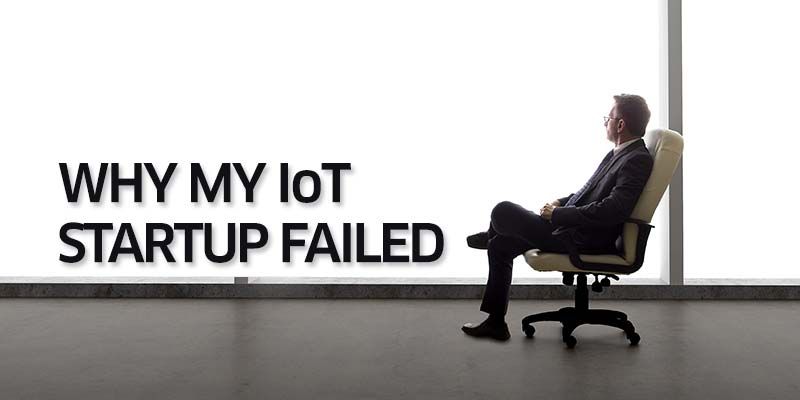After five months of toiling 14-hour days, making a hardware IoT (Internet of Things) product from scratch and spending lakhs of rupees of investor money, it suddenly dawned to me and my two founders that our product won’t sell.
We had to do something about it or the startup was doomed. The month was December 2014.
Being first-time entrepreneurs, we made tons of mistakes. I’ll mention the top seven mistakes we made that led to our failure. But first the story to give you some background!

July 2014
Our vision was to make super-smart internet connected switches that learn from user behaviour and personalize electronic appliances in a home to its owner. We named the product Lumos (Yes, I am a big Harry Potter Fan!)
We headed off to our alma mater, IIT-Gandhinagar, to get incubated after taking some pre-seed money from an angel investor. We converted a lab into our office space and the Lumos saga started!
We built like crazy. Being engineers, provided with an interesting problem to solve, we forgot everything else and just built. Our first prototype, which automated lights, was ready in 45 days.
The second prototype, which could automate lights, fans, ACs and water heaters was out in another month. Pretty fast for a 2-person team, building hardware and software at the same time!
November 2014
We got one more co-founder on board to help us out with machine learning. In mid-November, we started moving from the ugly-but-functional prototype stage to the beautiful product stage. In December, we were already in talks with investors to raise the next round of funding.
We were on track to have a hardware product on the market in less than one year. We were pleased with ourselves. The investors were pleased with us. Life was good.
December 2014
Until it was not. We had underestimated the work, time and funding that goes into making a market-ready hardware product. We had overestimated the demand and utility of our product.
“Hardware products sell at 4 to 5 times the component costs. How did we not know this?”
Our price estimates were wildly off the mark. And when all this realization came together, we were in a crisis.
January 2015-April 2015
We were forced into making major pivots.. We had to go back to the drawing board and think about what we should work on.
Not knowing what you will work on might just be second to running out of money, in the list of worst things that can happen in a startup.
We made bigger mistakes. We left IoT as a sector. One of our co-founders decided to call it a day and take up a job.
Now that you have some background, here are the top seven mistakes we made in Lumos and what we learnt from them.
Mistake 1: We were neither experts nor target users of the product that we were building
We had never used the existing home automation products in our homes. We were not veterans in the IoT sector. When you are inexperienced at something, you give yourself the famous Dunning-Kruger pass on your decisions.
Had we been users of existing smart switches, we would have known that the incremental value that our product was offering was quite low. Had we been experts in IoT, we would have known how to price hardware, and the difficulties in building it.
By avoiding this mistake, you can avoid a lot of other mistakes which happen as a result of this one.
Learning: Work on something where you are either an expert or a top user. If not, become an expert/top user.
Homejoy Founder Adora Cheung herself worked as a professional cleaner to understand the business.
Mistake 2: We did not do the due diligence on the idea before we started building the product
We did not understand the market and competition well enough. We also did not figure out the persona of our customer, and whether the customer was looking for the value that we were providing.
It is always possible to validate or invalidate a lot of assumptions about the product, market and competition without building the full-fledged product.
One way we could have done it was by selling existing products to our potential customers.
Learning: I learnt this very useful method in an accelerator. Make a thorough list of hinge-breaking assumptions for your market, product and competition. Hinge breaking assumptions are those that can make or break your company.
Rank them according to probability of the assumption being wrong and subsequent risk to company. Start validating from the top while building as less as possible.
Mistake 3: We thought that we were smarter than everyone else
I have seen this in dozens of entrepreneurs I met in the past year. I think it comes as a part of the entrepreneurial mindset; which makes cash-strapped entrepreneurs take on billion dollar companies and beat them at their game.
But it can also be a lethal trap; as it was in our case. We knew that companies like Belkin sold internet-connected switches at $50. How can they be so stupid? Don’t they understand that selling switches at a lower cost will give them better volumes? We will sell smarter switches at half the price. (Yeah, right!)
Nest’s machine learning algorithm is not perfect. But ours will be. You get the idea.
Learning: You will have to be smarter than your competitors to beat them. But you should be able to quantify why. You should have a logical answer to the famous YC question: “What do you understand about your business that other companies in it just don’t get?”
Answers like “Machine Learning” and “Better Design” usually don’t make the cut. You have to understand that your established competitors have more resources and more hiring power (Andrew Ng works with Google!). To beat them, you should be doing something fundamentally different.
Mistake 4: The ROI for our product did not make sense
The incremental value that Lumos switches provided did not justify the cost that the target customer had to pay for it.
Learning: The value-pain equation for your product should make sense for your target customer. Unless value>pain, your product will not sell.
The product will not sell because it is cool; or because the market is projected to be worth $19 trillion in the next 5 years. It will only sell if customers get significant value out of the product.
Mistake 5: We let sunk cost bias affect our decisions about pivoting
It was not that we were clueless about the problems in our product. We had doubts in our minds. In a startup, you almost always have doubts. But we had built so much. We were in love with our product. And we were not ready to ask the difficult questions.
Is it okay to be doubtful about your product? Is it okay to voice your doubts and bring the team morale down?
Or make your co-founders feel that you are not as committed to the idea and the vision as they are?
“It helps to be transparent about your doubts with co-founders in the long run.”
It would have saved us a couple of months and some money.
Learning: It is absolutely necessary for founders to be committed to the vision of the company. However, there are multiple ways to achieve a vision. Don’t fall in love with it one way. Accept the possibility that you might have to start things over from scratch.
Build a culture of transparency in your company. Encourage dissent among co-founders and deal with it objectively.
Mistake 6: We were trying to do everything for everybody
We were making switches that could automate your lights, fans, ACs and water heaters. We would have tried to automate your TV, Fridge, Oven and Car as well had it been feasible to do so.
We were pitching power savings as well as luxury. This made the product and the pitch very complicated.
Learning: As a startup, you are constrained by your resources. So it is always better to identify and solve one problem very well instead of solving n problems in a so-so way.
Nest solved the heating problem. Dropcam and Canary solved the security problem. Try to be a drug for your customer instead of being a vitamin.
Mistake 7: We underestimated hardware
Building a successful startup is hard. Building a hardware startup is 10 times harder.
Pebble, with all its Kickstarter success, is still in troubled waters.
Building a prototype is the easiest part of building a hardware startup. The real challenge comes in product design, production engineering, manufacturing, distribution and marketing/sales. And you need to have friends in China.
Also, hardware product validation and iteration cycles are much longer than software ones. Getting funding is relatively difficult; VCs ask for traction (~$1M on Kickstarter/Indiegogo, last I heard) because of the inherent risk in a hardware startup.
Managing cash flows is hard because you have to pay your vendors months before you get paid from your customers.(source)
Considering all this, we were not the right team to build a hardware company.
Learning: Understand what you are getting into if you are starting a hardware company and plan accordingly. Get experienced people on your team or get into a hardware accelerator like HAXLR8R.
Today
Eventually, we ended up leaving hardware and IoT and decided to build something that solves a problem that we had experienced. Since Gandhinagar (where Lumos was located) does not have many startups, interacting and sharing experiences with other entrepreneurs was always a big problem for us. Also, we had to subscribe to a lot of blogs (crowded inbox) just to stay updated with top content on Entrepreneurship.
We decided to build FundaMine to solve this problem.
FundaMine is a community for professionals to discover what experts in their profession are reading and discussing. FundaMine has communities (mines) on Entrepreneurship, Product Management, Android Development and IoT. Do check it out and wish us luck!








![[Funding alert] Workflow automation app Delightree raises $3M in seed round](https://images.yourstory.com/cs/2/b3bfb136ab5e11e88691f70342131e20/Delightree-1596266034279.jpg)